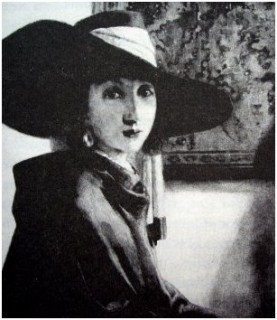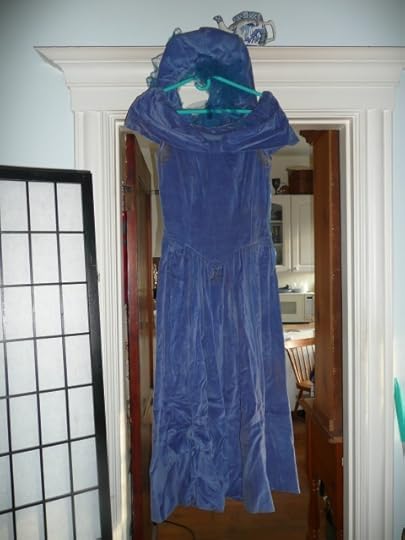Greer Gilman's Blog, page 89
June 19, 2011
"Labor is blossoming..."
I found such a lovely unexpected thing this weekend: my mother's portfolio from 1947, with her stories, scripts, ads, layouts, photography. She'd done "gay, fast patter" for teen girls; fashion pages; inflight magazines; high-minded educational filmscripts; ads for Philco; radio plays and early television; text and pictures for a feature on Selma Burke. I found a sheaf of manuscripts, and scattered gleanings of pages: short stories, a Sherlockian film scenario I found her packet from her summer at Bread Loaf.
And she never told me, not all this. Oh, bits and pieces of it, over the years: how she'd met James Baldwin once (more than once?) at a friend's place; how Twentieth Century Fox had been in talks with her, over her Nero Wolfe treatment. ("What happened?" I asked. "I met your father.") And only in her last year, almost too late: how that summer at Bread Loaf was cut short by her mother's death.
All in the attic, shoved under the eaves.
Oh, how I would have loved that black book as a child! I would have begged to take it out on rainy days; have turned the pages with delight and awe. Asked questions. Heard stories.
I wish I could tell her: how I wish I'd known that girl.
Nine
And she never told me, not all this. Oh, bits and pieces of it, over the years: how she'd met James Baldwin once (more than once?) at a friend's place; how Twentieth Century Fox had been in talks with her, over her Nero Wolfe treatment. ("What happened?" I asked. "I met your father.") And only in her last year, almost too late: how that summer at Bread Loaf was cut short by her mother's death.
All in the attic, shoved under the eaves.
Oh, how I would have loved that black book as a child! I would have begged to take it out on rainy days; have turned the pages with delight and awe. Asked questions. Heard stories.
I wish I could tell her: how I wish I'd known that girl.
Nine
Published on June 19, 2011 20:03
June 10, 2011
Fraud, Interrupted
Having heard Jonathan Lopez speak at the MFA at year or two back, I finally got around to reading his book on Han van Meegeren, The Man Who Made Vermeers.
Fakes are a hobbyhorse of mine; and van Meegeren was astoundingly slick. He had the brass balls to fake Vermeer, the painter of numinous commonplace, of the everyday sublime. And he forged himself. A lifelong crook, he recast himself as the little man who dreamed big, who only wanted to be hailed (to hug himself in modest secret) as the genius that he truly was. A fawning collaborator, filthy rich amid the starving Dutch, who were living by that time on watered tulip-gruel, he became a folk hero, a Robin Hood, to postwar Holland: the man who made a monkey out of Goering. Right in der Führer’s face!
His interrogator so loved the narrative they made together, that all the forger’s war crimes seemed to slip away like last night’s ice. His arrest for the high treason of selling Dutch cultural heritage to the Third Reich turned into a cabaret of a trial for forgery, over which he presided mockingly. Brief triumph: he died a few months later of a syphilitic heart.
This is The Supper at Emmaus that was called “the masterpiece of Johannes Vermeer of Delft”:

Sad, isn’t it? It has all the grace of carved cinderblock, and all the wondrous luminosity of cheap linoleum—which it is, being painted in Bakelite. Great stuff, Bakelite: impervious to all the art-historical tests of his time.
What’s curious about good fakes is that they seem so timeless for a while, then all at once so ludicrously dated. I have seen the “Clara Bow Botticelli” (so named by Kenneth Clarke); sadly, the “Greta Garbo Vermeer” is in limbo.

Some of Vermeer’s earlier late paintings have a kind of louche charm; but deeper in the 30s and 40s, van Meegeren’s puppeting got ugly. Cynically or otherwise, he made Vermeer an Ur-Fascist.
Here is van Meegeren’s Christ and the Adulteress (ca. 1943)—the painting that Goering chose to flee the Allies with, wrapped round a piece of stovepipe: all but last among his spoils:

And here is Hans Schachinger’s Abscheid (1940):

Christ in uniform. Either van Meegeren thought this was truly a holy war, or was pimping cynically to those who did. Either way he’s despicable.
Coolest trivia: van Meergeren’s later Vermeers were painted in Bakelite; John Myatt’s fake Dubuffets were painted with K-Y jelly. Dear art world: Up yours!
Nine
Fakes are a hobbyhorse of mine; and van Meegeren was astoundingly slick. He had the brass balls to fake Vermeer, the painter of numinous commonplace, of the everyday sublime. And he forged himself. A lifelong crook, he recast himself as the little man who dreamed big, who only wanted to be hailed (to hug himself in modest secret) as the genius that he truly was. A fawning collaborator, filthy rich amid the starving Dutch, who were living by that time on watered tulip-gruel, he became a folk hero, a Robin Hood, to postwar Holland: the man who made a monkey out of Goering. Right in der Führer’s face!
His interrogator so loved the narrative they made together, that all the forger’s war crimes seemed to slip away like last night’s ice. His arrest for the high treason of selling Dutch cultural heritage to the Third Reich turned into a cabaret of a trial for forgery, over which he presided mockingly. Brief triumph: he died a few months later of a syphilitic heart.
This is The Supper at Emmaus that was called “the masterpiece of Johannes Vermeer of Delft”:

Sad, isn’t it? It has all the grace of carved cinderblock, and all the wondrous luminosity of cheap linoleum—which it is, being painted in Bakelite. Great stuff, Bakelite: impervious to all the art-historical tests of his time.
What’s curious about good fakes is that they seem so timeless for a while, then all at once so ludicrously dated. I have seen the “Clara Bow Botticelli” (so named by Kenneth Clarke); sadly, the “Greta Garbo Vermeer” is in limbo.

Some of Vermeer’s earlier late paintings have a kind of louche charm; but deeper in the 30s and 40s, van Meegeren’s puppeting got ugly. Cynically or otherwise, he made Vermeer an Ur-Fascist.
Here is van Meegeren’s Christ and the Adulteress (ca. 1943)—the painting that Goering chose to flee the Allies with, wrapped round a piece of stovepipe: all but last among his spoils:

And here is Hans Schachinger’s Abscheid (1940):

Christ in uniform. Either van Meegeren thought this was truly a holy war, or was pimping cynically to those who did. Either way he’s despicable.
Coolest trivia: van Meergeren’s later Vermeers were painted in Bakelite; John Myatt’s fake Dubuffets were painted with K-Y jelly. Dear art world: Up yours!
Nine
Published on June 10, 2011 22:55
June 8, 2011
"Sometime, a thousand twangling instruments..."
Ooh! Today's Google Doodle, in honor of Les Paul, is a playable guitar. You can even record your doodle noodling, as offices around the galaxy go mad with the tuneless twangling.
Nine
Nine
Published on June 08, 2011 23:49
Cold maids
In 1569, Jane Shaxspere, picking marigolds beside a mill-pond, tumbled in and was drowned; in 1579, Katherine Hamlet fell or flung herself into the Avon, and was likewise drowned.
Perhaps a local boy named William made a fiddle of their bones.
With thanks to![[info]](https://i.gr-assets.com/images/S/compressed.photo.goodreads.com/hostedimages/1380451598i/2033940.gif) ron_drummond
.
ron_drummond
.
Nine
Perhaps a local boy named William made a fiddle of their bones.
With thanks to
![[info]](https://i.gr-assets.com/images/S/compressed.photo.goodreads.com/hostedimages/1380451598i/2033940.gif) ron_drummond
.
ron_drummond
.Nine
Published on June 08, 2011 00:42
June 6, 2011
Attic, Greek
My new Second Shovel in the household archeology is splendid: a whirlwind and an up-and-coming fantasist, most excellent company. She and I hauled about a dumpster's worth of trash out of one of the cellars (there are five, plus a crawl space), and then worked wonders on the larger attic, which was crammed from the eaves to the ridgepole with dusty boxes. (No evidence of mice, thank heavens.) I thought we'd better do it while the weather's still cool. It's going to be a hellhole in about a week. Even so, it was tough going: you can't stand up in there, except on the staircase. I felt my back cramping, tried to unbend, and smashed my head against the one lightbulb in a shower of glass, a stench of singed hair, and a fall of abject darkness. My prentice's mother came and unscrewed the old stump of bulb with half a potato--isn't she clever?
And it all was worth it.
Under some educational toy skeletons and a plastic skeeball game, I found a box with my mother's wedding dress, the loveliest periwinkle blue velvet, the color of her eyes. I hadn't seen that in decades, and feared it was gone. And I found one of her screen treatments, a club story/murder mystery called "The League of Four." I found some of my childhood drawings (from my colonial history phase, at about seven or eight), and my toy punch-card computer from about 1961, and boxes of my college work. I so hope my paper on Antony & Cleopatra is in there, with the professor's comment: "O rare![[info]](https://i.gr-assets.com/images/S/compressed.photo.goodreads.com/hostedimages/1380451598i/2033940.gif) nineweaving
!" I did (on first riffle) find a paper on Tiresias that I wrote for Katherine Geffcken: "Your mode of expression is often felicitous."
nineweaving
!" I did (on first riffle) find a paper on Tiresias that I wrote for Katherine Geffcken: "Your mode of expression is often felicitous."

Nine
And it all was worth it.
Under some educational toy skeletons and a plastic skeeball game, I found a box with my mother's wedding dress, the loveliest periwinkle blue velvet, the color of her eyes. I hadn't seen that in decades, and feared it was gone. And I found one of her screen treatments, a club story/murder mystery called "The League of Four." I found some of my childhood drawings (from my colonial history phase, at about seven or eight), and my toy punch-card computer from about 1961, and boxes of my college work. I so hope my paper on Antony & Cleopatra is in there, with the professor's comment: "O rare
![[info]](https://i.gr-assets.com/images/S/compressed.photo.goodreads.com/hostedimages/1380451598i/2033940.gif) nineweaving
!" I did (on first riffle) find a paper on Tiresias that I wrote for Katherine Geffcken: "Your mode of expression is often felicitous."
nineweaving
!" I did (on first riffle) find a paper on Tiresias that I wrote for Katherine Geffcken: "Your mode of expression is often felicitous."
Nine
Published on June 06, 2011 19:44
June 1, 2011
"Ere one can say, 'It lightens'"
Published on June 01, 2011 19:04
May 31, 2011
Just Heard the Queen Mum On The Radio . . .
This, for amateurs of lunacy, is the most appalling timesink.
Here's a Baconian:
It's all too obvious to me that the Strat trashing of Bacon -- which goes on even as I write -- is the chief cause of environmental collapse.
We had William Shappere [her preferred spelling] forced on us while Bacon, a natural philosopher whose works created a bevy of philosophers on the Continent -- Kant dedicated the First Critique to Bacon -- while the Strats, even today, are still asserting that Bacon was a "pedophile" and "pederast" on Bacon's Wikipedia page.
In fact Bacon was not only the first natural philosopher the English produced after Occam, he was also a SHAMELESS CUCKHOLD, he slept with other mens' wives and essentially engineered his own "fall" by fostering a beautiful daughter on Coke's wife.
Well, Coke's wife was Bacon's first cousin, at least Bacon kept it in the family.
Strats have overseen the destruction of the environment of this planet. They continue to promote an illiterate broker as the author of
WORKS OF NATURAL HISTORY
meaning the Shakespeare plays while at the same time doing irreversible damage to the reputation of the Natural Philosopher who left us with nineteen volumes of works.
And here an Oxfordian speaks, de haut en bas, as is his wont:
SOME of the sonnets are 'addressed' to
others, e.g. in Sonnet 126 "O thou my louely Boy"
is an insulting way to speak to Raleigh. Sonnet 75
is, in part, addressed to his departing turd. Likewise
Sonnet 26 to his erect penis. And so on. The poet
led a complicated life and his poems reflect that.
Nine
Here's a Baconian:
It's all too obvious to me that the Strat trashing of Bacon -- which goes on even as I write -- is the chief cause of environmental collapse.
We had William Shappere [her preferred spelling] forced on us while Bacon, a natural philosopher whose works created a bevy of philosophers on the Continent -- Kant dedicated the First Critique to Bacon -- while the Strats, even today, are still asserting that Bacon was a "pedophile" and "pederast" on Bacon's Wikipedia page.
In fact Bacon was not only the first natural philosopher the English produced after Occam, he was also a SHAMELESS CUCKHOLD, he slept with other mens' wives and essentially engineered his own "fall" by fostering a beautiful daughter on Coke's wife.
Well, Coke's wife was Bacon's first cousin, at least Bacon kept it in the family.
Strats have overseen the destruction of the environment of this planet. They continue to promote an illiterate broker as the author of
WORKS OF NATURAL HISTORY
meaning the Shakespeare plays while at the same time doing irreversible damage to the reputation of the Natural Philosopher who left us with nineteen volumes of works.
And here an Oxfordian speaks, de haut en bas, as is his wont:
SOME of the sonnets are 'addressed' to
others, e.g. in Sonnet 126 "O thou my louely Boy"
is an insulting way to speak to Raleigh. Sonnet 75
is, in part, addressed to his departing turd. Likewise
Sonnet 26 to his erect penis. And so on. The poet
led a complicated life and his poems reflect that.
Nine
Published on May 31, 2011 18:03
May 25, 2011
Soup of the evening, beautiful Soup!
Quite an evening of diversions yesterday with
![[info]](https://i.gr-assets.com/images/S/compressed.photo.goodreads.com/hostedimages/1380451598i/2033940.gif) teenybuffalo
: an Indian dinner; a reading by China Miéville; a turn round a garden with the irises in flower; a screening of Jan Švankmajer's astonishing Alice (Něco z Alenky); and tea in the Algiers' maze of mirrors.
teenybuffalo
: an Indian dinner; a reading by China Miéville; a turn round a garden with the irises in flower; a screening of Jan Švankmajer's astonishing Alice (Něco z Alenky); and tea in the Algiers' maze of mirrors.
Miéville was rather fiercely brilliant and witty, with talk ranging from the joy of stage dives to Professorenromane, from Cairo ("ZOMG! It's a conflict between Stuff and Space!") to taboo (one of his teacher's Amazonian informants admitting, "Well, you can, but you really shouldn't"), and lots of muscular ferocious leftiness. He defines bolshie.
April asked him about this and brought the house down.
Švankmajer's Alice is brilliantly weird. It's like my childhood nightmares, but wittier. Like the Jonathan Miller version, it works as dream logic; but that earlier film is psychological: polite, well-buttoned, absolute madness. It's about society, however crazed. This is purely surreal. The White Rabbit bleeds sawdust from a gash, and eats it up again, to flesh himself out; chittering bone-creatures hatch from eggs; the Caterpillar is a sock who darns his eyes shut when he wants to sleep. Table drawers spit keys and scissors; eat children. It all seems to take place in the ruins of the Museum of Comparative Zoology, the rag-and-bone shop of the brain.
Nine
![[info]](https://i.gr-assets.com/images/S/compressed.photo.goodreads.com/hostedimages/1380451598i/2033940.gif) teenybuffalo
: an Indian dinner; a reading by China Miéville; a turn round a garden with the irises in flower; a screening of Jan Švankmajer's astonishing Alice (Něco z Alenky); and tea in the Algiers' maze of mirrors.
teenybuffalo
: an Indian dinner; a reading by China Miéville; a turn round a garden with the irises in flower; a screening of Jan Švankmajer's astonishing Alice (Něco z Alenky); and tea in the Algiers' maze of mirrors.Miéville was rather fiercely brilliant and witty, with talk ranging from the joy of stage dives to Professorenromane, from Cairo ("ZOMG! It's a conflict between Stuff and Space!") to taboo (one of his teacher's Amazonian informants admitting, "Well, you can, but you really shouldn't"), and lots of muscular ferocious leftiness. He defines bolshie.
April asked him about this and brought the house down.
Švankmajer's Alice is brilliantly weird. It's like my childhood nightmares, but wittier. Like the Jonathan Miller version, it works as dream logic; but that earlier film is psychological: polite, well-buttoned, absolute madness. It's about society, however crazed. This is purely surreal. The White Rabbit bleeds sawdust from a gash, and eats it up again, to flesh himself out; chittering bone-creatures hatch from eggs; the Caterpillar is a sock who darns his eyes shut when he wants to sleep. Table drawers spit keys and scissors; eat children. It all seems to take place in the ruins of the Museum of Comparative Zoology, the rag-and-bone shop of the brain.
Nine
Published on May 25, 2011 20:05
May 23, 2011
Bird on briar
First sighting in the wild of The Cambridge Companion to Fantasy Literature, edited by
![[info]](https://i.gr-assets.com/images/S/compressed.photo.goodreads.com/hostedimages/1380451598i/2033940.gif) chilperic
and
chilperic
and
![[info]](https://i.gr-assets.com/images/S/compressed.photo.goodreads.com/hostedimages/1380451598i/2033940.gif) fjm
:
fjm
:
Introduction Edward James and Farah Mendlesohn; Part I. Histories: 1. Fantasy from Dryden to Dunsany Gary K. Wolfe; 2. Gothic and horror fiction Adam Roberts; 3. American fantasy, 1820-1950 Paul Kincaid; 4. The development of children's fantasy Maria Nikolajeva; 5. Tolkien, Lewis, and the explosion of genre fantasy Edward James; Part II. Ways of Reading: 6. Structuralism Brian Attebery; 7. Psychoanalysis Andrew M. Butler; 8. Political readings Mark Bould and Sherryl Vint; 9. Modernism and postmodernism Jim Casey; 10. Thematic criticism Farah Mendlesohn; 11. The languages of the fantastic Greer Gilman; 12. Reading the fantasy series Kari Maund; 13. Reading the slipstream Gregory Frost; Part III. Clusters: 14. Magical realism Sharon Sieber; 15. Writers of colour Nnedi Okorafor; 16. Quest fantasies W. A. Senior; 17. Urban fantasy Alexander C. Irvine; 18. Dark fantasy and paranormal romance Roz Kaveney; 19. Modern children's fantasy Charlie Butler; 20. Historical fantasy Veronica Schanoes; 21. Fantasies of history and religion Graham Sleight.
Fabulous company, eh what?
Nine
![[info]](https://i.gr-assets.com/images/S/compressed.photo.goodreads.com/hostedimages/1380451598i/2033940.gif) chilperic
and
chilperic
and
![[info]](https://i.gr-assets.com/images/S/compressed.photo.goodreads.com/hostedimages/1380451598i/2033940.gif) fjm
:
fjm
:Introduction Edward James and Farah Mendlesohn; Part I. Histories: 1. Fantasy from Dryden to Dunsany Gary K. Wolfe; 2. Gothic and horror fiction Adam Roberts; 3. American fantasy, 1820-1950 Paul Kincaid; 4. The development of children's fantasy Maria Nikolajeva; 5. Tolkien, Lewis, and the explosion of genre fantasy Edward James; Part II. Ways of Reading: 6. Structuralism Brian Attebery; 7. Psychoanalysis Andrew M. Butler; 8. Political readings Mark Bould and Sherryl Vint; 9. Modernism and postmodernism Jim Casey; 10. Thematic criticism Farah Mendlesohn; 11. The languages of the fantastic Greer Gilman; 12. Reading the fantasy series Kari Maund; 13. Reading the slipstream Gregory Frost; Part III. Clusters: 14. Magical realism Sharon Sieber; 15. Writers of colour Nnedi Okorafor; 16. Quest fantasies W. A. Senior; 17. Urban fantasy Alexander C. Irvine; 18. Dark fantasy and paranormal romance Roz Kaveney; 19. Modern children's fantasy Charlie Butler; 20. Historical fantasy Veronica Schanoes; 21. Fantasies of history and religion Graham Sleight.
Fabulous company, eh what?
Nine
Published on May 23, 2011 13:23
May 20, 2011
Great roots, green branches
Published on May 20, 2011 22:26
Greer Gilman's Blog
- Greer Gilman's profile
- 42 followers
Greer Gilman isn't a Goodreads Author
(yet),
but they
do have a blog,
so here are some recent posts imported from
their feed.




